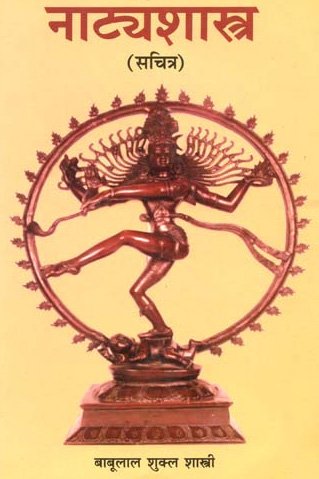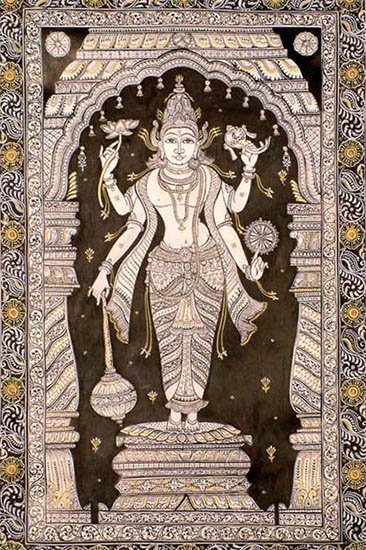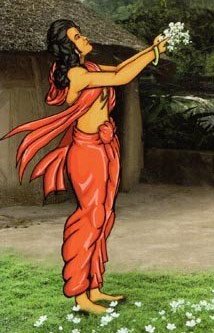Karnapura, Karṇapūra, Karna-pura, Karṇapura: 15 definitions
Introduction:
Karnapura means something in Hinduism, Sanskrit, the history of ancient India, biology. If you want to know the exact meaning, history, etymology or English translation of this term then check out the descriptions on this page. Add your comment or reference to a book if you want to contribute to this summary article.
In Hinduism
Natyashastra (theatrics and dramaturgy)
Source: Wisdom Library: Nāṭya-śāstraKarṇapūra (कर्णपूर) refers to a type of ornament (ābharaṇa) for the ears (karṇa) to be worn by females, according to Nāṭyaśāstra chapter 23. Such ornaments for females should be used in cases of human females and celestial beings (gods and goddesses).
Ābharaṇa (‘ornaments’, eg., karṇapūra) is a category of alaṃkāra, or “decorations”, which in turn is a category of nepathya, or “costumes and make-up”, the perfection of which forms the main concern of the Āhāryābhinaya, or “extraneous representation”, a critical component for a successful dramatic play.

Natyashastra (नाट्यशास्त्र, nāṭyaśāstra) refers to both the ancient Indian tradition (shastra) of performing arts, (natya—theatrics, drama, dance, music), as well as the name of a Sanskrit work dealing with these subjects. It also teaches the rules for composing Dramatic plays (nataka), construction and performance of Theater, and Poetic works (kavya).
Shilpashastra (iconography)
Source: Shodhganga: Vaisnava Agamas And Visnu ImagesKarṇapūra (कर्णपूर) refers to an “ear-pendant”, representing a type of ear-ornament (karṇabhūṣaṇa) for females, as defined in treatises such as the Pāñcarātra, Pādmasaṃhitā and Vaikhānasa-āgamas, extensively dealing with the technical features of temple art, iconography and architecture in Vaishnavism.—A number of ear-ornaments (Karṇabhūṣaṇa) are found in Indian sculptures. Bharata mentions two sets one for male and another for female. The ear-ornament for female are [viz., karṇapūra (ear-pendant)]

Shilpashastra (शिल्पशास्त्र, śilpaśāstra) represents the ancient Indian science (shastra) of creative arts (shilpa) such as sculpture, iconography and painting. Closely related to Vastushastra (architecture), they often share the same literature.
Kavya (poetry)
Source: Brill: Śaivism and the Tantric Traditions (kavya)Karṇapūra (कर्णपूर) refers to “ear-ornaments”, according to Bāṇa’s Kādambarī (p. 225-226).—Accordingly, while describing the shire of the Goddess Caṇḍikā, “[Then follows the image of the Goddess Caṇḍikā, which matches the conception of Kālarātri in the passage from the Mahābhārata:] [...] she bore the coquettish apparel of a woman going out to meet Mahākāla at night, with a vine-like body furnished with a raiment reddened with saffron-dye, with a face with red eyes, whose brows were furrowed into a frown, whose lip was crimsoned with betel that was blood, whose cheeks were reddened by the light shed from ear-ornaments (karṇapūra) of pomegranate flowers, with a forehead on which there was a tilaka dot of vermillion made by a Śabara beauty, covered by a magnificent gold turban. She was worshipped by goats... mice... antelope and black serpents... She was praised on all sides by flocks of old crows; [...]”.

Kavya (काव्य, kavya) refers to Sanskrit poetry, a popular ancient Indian tradition of literature. There have been many Sanskrit poets over the ages, hailing from ancient India and beyond. This topic includes mahakavya, or ‘epic poetry’ and natya, or ‘dramatic poetry’.
India history and geography
Source: Cologne Digital Sanskrit Dictionaries: Indian Epigraphical GlossaryKarṇapūra.—(EI 17), an ear-ornament. Note: karṇapūra is defined in the “Indian epigraphical glossary” as it can be found on ancient inscriptions commonly written in Sanskrit, Prakrit or Dravidian languages.

The history of India traces the identification of countries, villages, towns and other regions of India, as well as mythology, zoology, royal dynasties, rulers, tribes, local festivities and traditions and regional languages. Ancient India enjoyed religious freedom and encourages the path of Dharma, a concept common to Buddhism, Hinduism, and Jainism.
Biology (plants and animals)
Source: Google Books: CRC World Dictionary (Regional names)1) Karnapura in India is the name of a plant defined with Albizia lebbeck in various botanical sources. This page contains potential references in Ayurveda, modern medicine, and other folk traditions or local practices It has the synonym Acacia lebbek (L.) Willd. (among others).
2) Karnapura is also identified with Saraca indica It has the synonym Jonesia confusa Hassk. (etc.).
Example references for further research on medicinal uses or toxicity (see latin names for full list):
· Species Plantarum (1753)
· Species Plantarum.
· Mantissa Plantarum (1767)
· Flora Indica (1768)
If you are looking for specific details regarding Karnapura, for example diet and recipes, pregnancy safety, side effects, health benefits, extract dosage, chemical composition, have a look at these references.

This sections includes definitions from the five kingdoms of living things: Animals, Plants, Fungi, Protists and Monera. It will include both the official binomial nomenclature (scientific names usually in Latin) as well as regional spellings and variants.
Languages of India and abroad
Sanskrit dictionary
Source: DDSA: The practical Sanskrit-English dictionaryKarṇapūra (कर्णपूर).—
1) an ornament (of flowers &c.) worn round the ear, an ear-ring; इदं च करतलं किमिति कर्णपूरतामारोपितम् (idaṃ ca karatalaṃ kimiti karṇapūratāmāropitam) K.6. प्रचुरसमरशोभासुभ्रुवः कर्णपूरः (pracurasamaraśobhāsubhruvaḥ karṇapūraḥ) Śiva. B.3.46.
2) the Aśoka tree.
3) the Śirīṣa tree.
4) the blue lotus.
Derivable forms: karṇapūraḥ (कर्णपूरः).
Karṇapūra is a Sanskrit compound consisting of the terms karṇa and pūra (पूर).
--- OR ---
Karṇapura (कर्णपुर).—the auditory passage of the ear.
Derivable forms: karṇapuram (कर्णपुरम्).
Karṇapura is a Sanskrit compound consisting of the terms karṇa and pura (पुर). See also (synonyms): karṇavivara, karṇachidra, karṇarandhra.
Source: Cologne Digital Sanskrit Dictionaries: Shabda-Sagara Sanskrit-English DictionaryKarṇapura (कर्णपुर).—m.
(-raḥ) The capital of Karna, the ancient name of Bhagalpur. E. karṇa, and pura city; also karṇapur f.
(-pūḥ).
--- OR ---
Karṇapūra (कर्णपूर).—m.
(-raḥ) 1. A tree, (Mimosa sirisha.) 2. The blue lotus. 3. An ear-ring. 4. The Asoka tree. E. karṇa. and pūra to make full, to complete.
Source: Cologne Digital Sanskrit Dictionaries: Benfey Sanskrit-English DictionaryKarṇapūra (कर्णपूर).—m. 1. an ornament of the ear, [Uttara Rāmacarita, 2. ed. Calc., 1862.] 62, 13. 2. the name of several plants.
Karṇapūra is a Sanskrit compound consisting of the terms karṇa and pūra (पूर).
Source: Cologne Digital Sanskrit Dictionaries: Cappeller Sanskrit-English DictionaryKarṇapūra (कर्णपूर).—[masculine] [neuter] ornament for the ears, earring; ka [masculine] [Name] of a servant (Ear-filler).
Source: Cologne Digital Sanskrit Dictionaries: Aufrecht Catalogus Catalogorum1) Karṇapūra (कर्णपूर) as mentioned in Aufrecht’s Catalogus Catalogorum:—See Kavikarṇapūra.
2) Karṇapūra (कर्णपूर):—See Kavikarṇapūra.
Source: Cologne Digital Sanskrit Dictionaries: Monier-Williams Sanskrit-English Dictionary1) Karṇapūra (कर्णपूर):—[=karṇa-pūra] [from karṇa] m. n. an ornament ([especially] of flowers) worn round the ears, [Mahābhārata; Raghuvaṃśa; Kādambarī] etc.
2) [v.s. ...] a blue lotus-flower, [cf. Lexicographers, esp. such as amarasiṃha, halāyudha, hemacandra, etc.]
3) [v.s. ...] Acacia Sirissa, [cf. Lexicographers, esp. such as amarasiṃha, halāyudha, hemacandra, etc.]
4) [v.s. ...] Jonesia Asoka, [cf. Lexicographers, esp. such as amarasiṃha, halāyudha, hemacandra, etc.]
5) [v.s. ...] Name of the father of Kavicandra and author of the Alaṃkāra Kaustubha.
Source: Cologne Digital Sanskrit Dictionaries: Yates Sanskrit-English Dictionary1) Karṇapura (कर्णपुर):—[karṇa-pura] (raḥ) 1. m. The capital of Karna; Bhagulpur.
2) Karṇapūra (कर्णपूर):—[karṇa-pūra] (raḥ) A mimosa tree; blue lotus; ring; Asoka tree.
[Sanskrit to German]
Sanskrit, also spelled संस्कृतम् (saṃskṛtam), is an ancient language of India commonly seen as the grandmother of the Indo-European language family (even English!). Closely allied with Prakrit and Pali, Sanskrit is more exhaustive in both grammar and terms and has the most extensive collection of literature in the world, greatly surpassing its sister-languages Greek and Latin.
Kannada-English dictionary
Source: Alar: Kannada-English corpusKarṇapūra (ಕರ್ಣಪೂರ):—[noun] a kind of ornament for the ear.
Kannada is a Dravidian language (as opposed to the Indo-European language family) mainly spoken in the southwestern region of India.
See also (Relevant definitions)
Starts with: Karnapura gosvamin, Karnapuraka, Karnapuram, Karnapurana.
Ends with: Akarnapura, Kavikarnapura, Rajendrakarnapura.
Full-text (+11): Hemantasimha, Damodara mishra, Karnapuraka, Kavikarnapura, Rajendrakarnapura, Karnapuram, Lokanatha cakravartin, Karnachidra, Karnarandhra, Karnavivara, Krishnahnika, Alamkarakaustubha, Aryashataka, Krishnahnikakaumudi, Varnaprakasha, Caitanyasahasranama, Gauraganoddesha, Caitanyacaritamahakavya, Caitanyasahasranamastotra, Caitanyacarita.
Relevant text
Search found 12 books and stories containing Karnapura, Karṇapūra, Karna-pura, Karṇapura, Karṇa-pūra, Karṇa-pura; (plurals include: Karnapuras, Karṇapūras, puras, Karṇapuras, pūras). You can also click to the full overview containing English textual excerpts. Below are direct links for the most relevant articles:
Cosmetics, Costumes and Ornaments in Ancient India (by Remadevi. O.)
2.2. Various other Ear Ornaments < [Chapter 3 - Ornaments]
Chaitanya Bhagavata (by Bhumipati Dāsa)
Verse 3.5.721 < [Chapter 5 - The Pastimes of Nityānanda]
Verse 1.2.34 < [Chapter 2 - The Lord’s Appearance]
Verse 1.14.2 < [Chapter 14 - The Lord’s Travel to East Bengal and the Disappearance of Lakṣmīpriyā]
A History of Indian Philosophy Volume 4 (by Surendranath Dasgupta)
Part 1 - Caitanya’s Biographers < [Chapter XXXII - Caitanya and his Followers]
Sahitya-kaumudi by Baladeva Vidyabhushana (by Gaurapada Dāsa)
Text 7.111 < [Chapter 7 - Literary Faults]
Harshacharita (socio-cultural Study) (by Mrs. Nandita Sarmah)
4. Health and Hygiene Consciousness < [Chapter 7 - Environmental awareness and Hygiene Conciousness]
The Brahma Purana (by G. P. Bhatt)